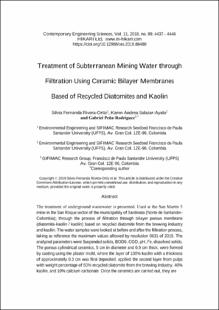Treatment of subterranean mining water through filtration using ceramic bilayer membranes based of recycled diatomites and kaolin
...
RIVERA, SILVIA FERNANDA | 2018-10-22
The treatment of underground wastewater is presented. Used at the San Martín 5
mine in the San Roque sector of the municipality of Sardinata (Norte de SantanderColombia); through the process of filtration through bilayer porous membrane
(diatomite-kaolin / kaolin) based on recycled diatomite from the brewing industry
and kaolin. The water samples were looked at before and after the filtration process,
taking as reference the maximum values allowed by resolution 0631 of 2015. The
analyzed parameters were Suspended solids, BOD5, COD, pH, Fe, dissolved solids.
The porous cylindrical ceramics, 5 cm in diameter and 0.9 cm thick, were formed
by casting using the plaster mold, where the layer of 100% kaolin with a thickness
of approximately 0.3 cm was first deposited. applied the second layer from pulps
with weight percentage of 50% recycled diatomite from the brewing industry, 40%
kaolin, and 10% calcium carbonate. Once the ceramics are carried out, they aresubject to the drying process at room temperature for 24 hours, then by means of
the forced circulation oven Memmert UF-110 at 100 ° C for an equal time. The
sintering of the ceramic was carried out in Vulcan D-130 electric muffle, at a
maximum temperature of 1000 ° C for two hours, with a heating ramp of 10 ° C /
min. The morphology of the ceramics was studied using scanning electron
microscopy (SEM), while physical-ceramic analyzes were performed in accordance
with ISO 10545-3. The results show that the ceramic membrane is, in fact, 52% for
the reduction of total solids, while the elimination of iron is 38%, on the other hand,
it is also evident that the ceramics are not effective in the treatment of dissolved
solids with high concentrations
LEER










